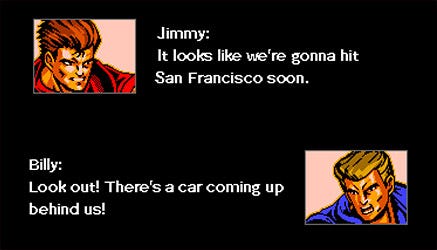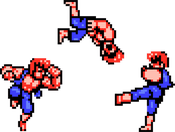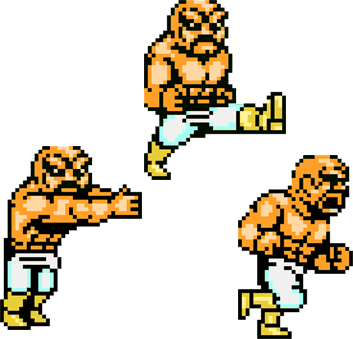Trending
Opinion: How will Project 2025 impact game developers?
The Heritage Foundation's manifesto for the possible next administration could do great harm to many, including large portions of the game development community.
The makers of the classic 1987 arcade brawler Double Dragon reunited to create a sequel that looks and plays exactly like earlier entries in the series. They discuss their retro revival with us.

The new release Double Dragon IV is a defiantly retro brawler with a distinguished pedigree.
The 1987 arcade hit Double Dragon was a trailblazing entry in the “beat ‘em up” genre. Two brothers named Billy and Jimmy Lee sought revenge on behalf of their love interest Marian, kicking and punching and elbow smashing their way through scores of foes.
Its success would lead to a string of similar hits both in the arcade and at home. Its formula cropped up in everything from Final Fight to Streets of Rage to a bevy of licensed games featuring comic book and pop culture heroes such as TMNT, X-Men, and The Simpsons.
When the arcade original came to the Famicom and NES in 1988, the series was introduced to millions of converts, setting the stage for a long-running franchise. After a number of sequels and two side-project fighting games, the original team of developers disbanded in 1995 as their studio, Technos, went out of business.
Three decades after the first title appeared, the team is getting back together with Double Dragon IV.
Co-developed with Arc Systems Works, the sequel is a return to the look and action of the 8-bit games, and released on PC and PS4 on January 30th. The game is a continuation of the story from the 1991 console title Double Dragon II: The Revenge, and the graphical style perfectly matches the look of that NES/Famicom classic. We spoke to the developers about the making of their aggressively old school brawler.

There have been many retro-inspired games in recent years, or attempts to relaunch old franchises in new styles (like Double Dragon Neon). Why did the team decide to hew so closely to the NES version of Double Dragon for DDIV?
"We haven’t made use of any new technology whatsoever. We restricted it to content that would have been possible on the Famicom."
Takaomi Kaneko, producer at Arc System Works: The game was made with a focus on Japan, and we wanted people to remember the old Double Dragon games, while providing a new game. The original Double Dragon had various styles of artwork, depending on the hardware and region it was sold in. Thus we decided to base this game on Double Dragon 2, which had virtually the same artwork and in-game illustrations in both Japan and abroad. Another reason for basing it off of DD2 is because a new game in the series hasn’t come out in Japan for a long time (V was not released there), and DD2 on Famicom was especially popular in Japan.
At the start of development, we considered changing from retro graphics to a different style, but everyone had their own images in their minds. We decided to leave the graphics as they were in Double Dragon 2 on Famicom, because changing it seemed like it wouldn’t fit the image of the past games, and different regions would have different tastes in graphic styles. The graphic designers are the original staff from before, so I don’t think the new characters feel out of place at all!
Yoshihisa Kishimoto, creator of Double Dragon and director of DDIV: Younger generations may think that an old game has been re-released. We didn’t do any focus testing with younger children. I think Famicom users will feel like they did playing in the past, and will be happy.

Kishimoto: The project was 30 years ago, so our memories of it were rather hazy, and we had a hard time trying to remember everything.
Kishimoto: We decided to give Billy and Jimmy different combat abilities this time. But we haven’t made use of any new technology whatsoever. We restricted it to content that would have been possible on the Famicom.

 Kishimoto: I don’t think Double Dragon would have been created, as we know it at least. The time period influenced it. Hardware at the time supported a small number of colors, and capacity was hundreds of times smaller than modern hardware. When planning characters and backgrounds, that had to be kept in mind. We also had to use a color swap to differentiate between player 1 and 2, so the idea of twins fit in very well. On modern hardware, one really doesn’t have to think about capacity limits, so there’s no need to use twins. You could make them friends, or rivals, and give them entirely different costumes.
Kishimoto: I don’t think Double Dragon would have been created, as we know it at least. The time period influenced it. Hardware at the time supported a small number of colors, and capacity was hundreds of times smaller than modern hardware. When planning characters and backgrounds, that had to be kept in mind. We also had to use a color swap to differentiate between player 1 and 2, so the idea of twins fit in very well. On modern hardware, one really doesn’t have to think about capacity limits, so there’s no need to use twins. You could make them friends, or rivals, and give them entirely different costumes.
That wouldn’t result in Double Dragon, but it would have the same concept. There’s the idea of one versus many in a fighting-action game. The appearance and presentation would differ, but changing the method doesn’t necessarily change the nature of the game. I doubt the true nature of the game would change much at heart, but it would likely include battles in a 3D space, as well as many movie-like animations and sequences.

Abobo, one of the most memorable enemies in the Double Dragon franchise
Kishimoto: Seeing how 30 years have passed, I’d like to make a spin-off game. Like a muscular action game with Abobo as the hero, or a face off between Black Warriors and Renegade. Or a game where the Lee brothers are getting into fights as middle schoolers. It could be Young Double Dragon, with deformed characters similar to the Kunio series. I’ve got a lot of ideas, so I’d love to expand and liven up Double Dragon.
You May Also Like